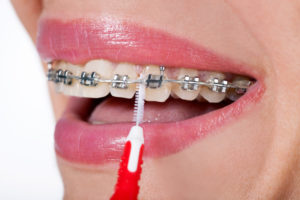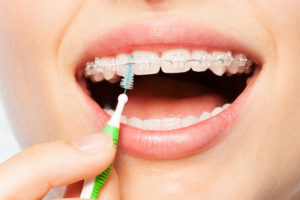Common Problems With Braces

As you begin orthodontic treatment, changes will occur in your mouth that could be uncomfortable or unexpected. Braces help patients get the beautiful and straight smiles that they deserve, but orthodontic treatment is not an easy process. As your teeth begin to shift, you can experience some tooth tenderness, lip sores, or pokey wires. These are all normal occurrences, but some patients can feel uneasy. Regular orthodontic visits can remedy these situations and help you feel back to normal in no time. Find out what to expect with braces and how you can treat these issues!
Problems That Braces Can Cause
As you begin orthodontic care, there are some problems to look out for that are commonly associated with braces. Although most of these issues are not serious, it is still good to know what to expect whenever you begin care. Once braces are placed, the process of fixing your malocclusion begins and your teeth will start to shift into their correct positions. As this occurs, soreness and swollen gums are both very common reactions to braces. Swollen gums can also influence tooth tenderness, which normally lasts between 2-4 days after braces are first placed. Dull aches can also accompany tooth tenderness but can be relieved by eating soft foods and an over-the-counter pain medication, if needed. Other common problems with braces include lip and cheek sores, pokey wires, and loose bands and/or brackets. Lip and cheek sores develop as the brackets rub against your mouth but can be remedied by placing a small piece of wax on the part of the braces that’s causing the irritation. Pokey wires can be caused by sticky foods or when a patient picks at their braces, and wax can also be used to cover the pokey piece or you can try pushing the wire back into place with a Q-tip or pencil eraser. Loose or broken bands and brackets normally aren’t considered an emergency and can be covered in wax until the next orthodontic appointment. If the broken bracket holds a rubber band in place or if a bracket on one of the upper or lower front teeth breaks, you will need an appointment as soon as possible to fix the bracket.
Serious problems that can be caused by braces include demineralization and gingivitis. Demineralization creates white scars that look like tiny white boxes and outline the area where the bracket used to be. These white scars are caused as food left on teeth come in contact with bacteria and create acid. The acid destroys calcium and phosphate in the teeth, which causes decalcification or white scars. Braces do not cause demineralization, but bad hygiene during treatment usually leads to white scars. Unfortunately, white scars normally don’t disappear after braces are removed and can even lead to cavities. Gingivitis, on the other hand, occurs as the gum tissues become inflamed and is one of the first steps to gum disease. Redness, swelling, tenderness and bleeding can result from gingivitis, but can be entirely prevented by brushing rigorously around the brackets and flossing regularly.
Importance of Good Oral Hygiene
Many problems that come with braces can be avoided or lessened by sticking to a strict oral hygiene regimen. To properly maintain your braces, make sure to brush after every meal, use threadable floss or a floss threader and use a proxabrush. Even though it may seem excessive to brush after each meal, this practice can get rid of remaining food that may be stuck in your braces and prevent plaque and acid from building up (which helps prevent demineralization and gingivitis). Floss threaders are placed between the teeth and under the wire to aid in flossing. Threaders help you floss between each tooth, which can be difficult to do with braces in the way. A proxabrush is typically referred to as a “Christmas tree brush” and helps clean between each bracket. By placing the proxabrush under the archwire and between each bracket, you can thoroughly clean the bracket and remove any stuck food particles.
Maintaining a good diet, especially during orthodontic care, should be another important part of your oral health routine. Sticky or hard foods, such as nuts, popcorn, gum, caramel and chips, can damage your orthodontic appliance and hurt your teeth. Although the temptation may be great to cheat and eat one of these items, the consequence of doing so can be costly and painful. Eating these foods also gives you a higher risk of developing cavities during your time with braces, which can be difficult to treat. Make a list of the foods you should and should not eat, and stick to your oral health goals to keep your teeth and braces healthy.
Starting Orthodontic Care On The Right Foot
If you or a member of your family is in need of orthodontic care, call Belmar Orthodontics at (303) 225-9016! Our dedicated staff is ready to help you achieve your oral health goals and get a beautiful, straight smile. Call now to find out what options we have for braces and how soon you can begin treatment!
Teeth Cleaning Habits To Have With Braces

Good oral hygiene is one of the most important goals that we should all have to maintain the health and strength of our teeth and gums. Once we get braces, however, our oral hygiene regimen will change to account for the new appliance in our mouths that we will have to clean around. Whether you have traditional braces or lingual braces, cleaning around the brackets and wires is essential in preventing cavities and tooth decay. There are many options to choose from to clean between teeth, such as a proxabrush, and other tools to thoroughly brush around the brackets, such as an electric toothbrush. Find out what all you can do to keep your smile healthy and bright with braces with these tips!
Extra Care For Teeth During Orthodontic Treatment
Orthodontic care is one of the most helpful and important dental treatments that patients have readily available to them. While there are many versions of braces that help straighten our teeth and fix misaligned bites, there are certain precautions that we need to take to ensure proper care for our orthodontic appliances and teeth. Brackets and wires in the mouth make it easier for food particles to get stuck in, which can lead to dental problems, like cavities. Proper oral hygiene is essential during your time with braces to avoid any preventable issues that can lengthen your treatment time or need special care to be fixed.
Since braces naturally create nooks and crannies where bacteria can hide, it is important to maintain a good oral hygiene regimen everyday so that you can avoid tooth decay and gum problems during orthodontic treatment. If teeth and brackets are not kept clean, permanent damage can occur to the tooth enamel, as well. When this occurs, white spots (tooth decay) can begin appearing on the teeth where the enamel surface has lost minerals, which cannot be reversed. Bleeding or inflamed gums, called gingivitis, is also common whenever patients don’t clean their teeth thoroughly enough with braces, and it can be very painful. While it is not likely that all of these issues will occur if you miss brushing your teeth or flossing well a few times, you will be more prone to an increased risk, which will hurt your oral health and complicate the rest of your orthodontic care.
Teeth Cleaning Options
Although cleaning your teeth with braces isn’t too difficult of a process for most patients, there are some tools that you can use to better clean around the hard-to-reach areas in your mouth and make your time cleaning more efficient. First and foremost, make sure that you (or your child) are brushing after each meal. It may seem insignificant, but brushing after you eat removes food particles that are stuck in braces, reduces staining and prevents bacteria buildup. Secondly, use a threadable floss or floss threader to clean underneath the wire of your braces. A floss threader works by inserting the pointed end between the teeth and under the archwire. From there, move it back and forth until it is able to thread the floss between the teeth. Then, you can floss the two teeth, on either side, to remove all food that may be stuck there. If you’re having trouble with your floss getting stuck, consider using waxed floss, which slides between the teeth easier and doesn’t get snagged.
After brushing and flossing, using a proxabrush is helpful in cleaning between each bracket. Commonly referred to as an interproximal brush or “Christmas tree brush,” a proxabrush is placed between two brackets, below the archwire, and uses an up-and-down motion to remove any lodged food particles that brushing and flossing can’t get to. Clean the brackets with the proxabrush on both sides, starting either up from the bottom or down from the top, and repeat between each tooth. Another option for hard-to-reach areas is an oral irrigator, which uses a pulsating stream of water to remove plaque and food debris. Mouthwash is also a helpful tool to kill and bacteria that may have been left after brushing and flossing. For an extra clean, try using an electric toothbrush to maximize cleaning and brush those difficult areas of the mouth that are hard to reach.
Braces-Friendly Diet
The foods we eat and the diet we have affect our oral health and can interfere with orthodontic appliances. Eating sugary or starchy foods can let plaque develop around the brackets, which can lead to cavities, staining or even gum disease. Sticky or chewy foods, such as caramel, taffy, chewing gum and corn on the cob, should also be avoided as they can easily become stuck between brackets and be difficult to remove. Hard foods, such as candy, beef jerky, nuts and popcorn, are also no-nos as they are known to break wires and loosen brackets. If you’re going to eat hard or crunchy foods, such as apples or carrots, make sure to cut them into small, bite-sized pieces to avoid any possible damage.
Regular Orthodontic Checkups
Even if you or your child are following these rules, it is essential that you visit with your orthodontist regularly so that they can monitor teeth movement and adjust any wires or brackets. Your orthodontist or hygienist can show you how to use the tools previously described and give you additional teeth cleaning supplies to aid you during treatment. For more questions about how to clean your teeth with braces or what foods to stay away from, contact Belmar Orthodontics at (303) 225-9016!
